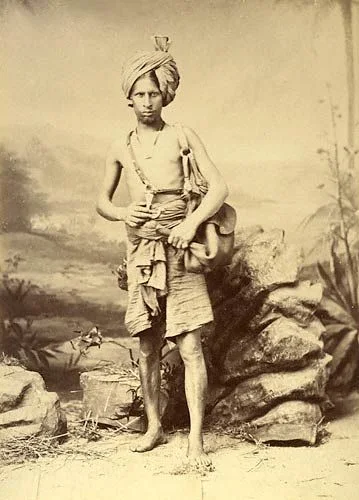An indigenous cooling device adopted by the sahibs was the installation of tatties made of khus-khus grass over all openings — windows and doors — of a house. Tatties were kept continually wet by a bhishtee,

BY CONSTANTLY WETTING WITH POT FULL OF WATER A WALL TO WALL 'TATTIE' MADE OF 'VETTIVER' GRASS ;ROOM WAS COOLED TO TOLERABLE TEMPERATURE

Tatties[MAT] made of khus khus Summer Curtain Made with Vetiver Roots
water carrier, engaged to throw water against these from outside.




 -------------------
-------------------
bhishtee,or a water carrier,
----------------------------------------------------------------------------------
native ice produced in ice pits
during winter nights and preserved for the summer, entailing colossal wastage. Small earthen pots filled with water were placed in an open field, and in the morning the coating of ice formed in the cold temperature of the night was collected and stored in ice-pits.

Icepits near Allahabad. Drawing by Fanny Parks c. 1830
BY CONSTANTLY WETTING WITH POT FULL OF WATER A WALL TO WALL 'TATTIE' MADE OF 'VETTIVER' GRASS ;ROOM WAS COOLED TO TOLERABLE TEMPERATURE
Tatties[MAT] made of khus khus Summer Curtain Made with Vetiver Roots
water carrier, engaged to throw water against these from outside.

bhishtee,or a water carrier,
----------------------------------------------------------------------------------
native ice produced in ice pits
during winter nights and preserved for the summer, entailing colossal wastage. Small earthen pots filled with water were placed in an open field, and in the morning the coating of ice formed in the cold temperature of the night was collected and stored in ice-pits.
Icepits near Allahabad. Drawing by Fanny Parks c. 1830
Indian Science and Technology in the 18th Century
The Process of Making Ice in the East Indies - By Sir Robert Barker published in 1775
The Process of Making Ice in the East Indies - By Sir Robert Barker published in 1775
Following
is the method that was used to make ice in India as it
was performed at Allahabad and Calcutta. On a large open
plain, 3 or 4 excavations were made, each about 30 feet square
and two deep; the bottoms of which were strewed about eight
inches or a foot thick with sugar-cane, or the stems of the
large Indian corn dried. Upon this bed were placed in
rows, near to each other, a number of small shallow,
earthen pans for containing the water intended to be
frozen. These are unglazed, scarce a quarter of an inch
thick, about an inch and a quarter in depth, and made of
an earth so porous, that it was visible, from the
exterior part of the pans, the water had penetrated the
whole substance. Towards the dusk of the evening, they were
filled with soft water, which had been boiled, and then left in
the afore-related situation. The ice-makers attended the
pits usually before the sun was above the horizon, and
collected in baskets what was frozen, by pouring the
whole contents of the pans into them, and thereby
retaining the ice, which was daily conveyed to the grand
receptacle or place of preservation, prepared generally
on some high dry situation, by sinking a pit of
fourteen or fifteen feet deep, lined first with straw, and
then with a coarse king of blanketing, where it is beat down
with rammers, till at length its own accumulated cold again
freezes and forms one solid mass. The mouth of the pit is
well secured from the exterior air with straw and
blankets, in the manner of the lining, and a thatched
roof is thrown over the whole.